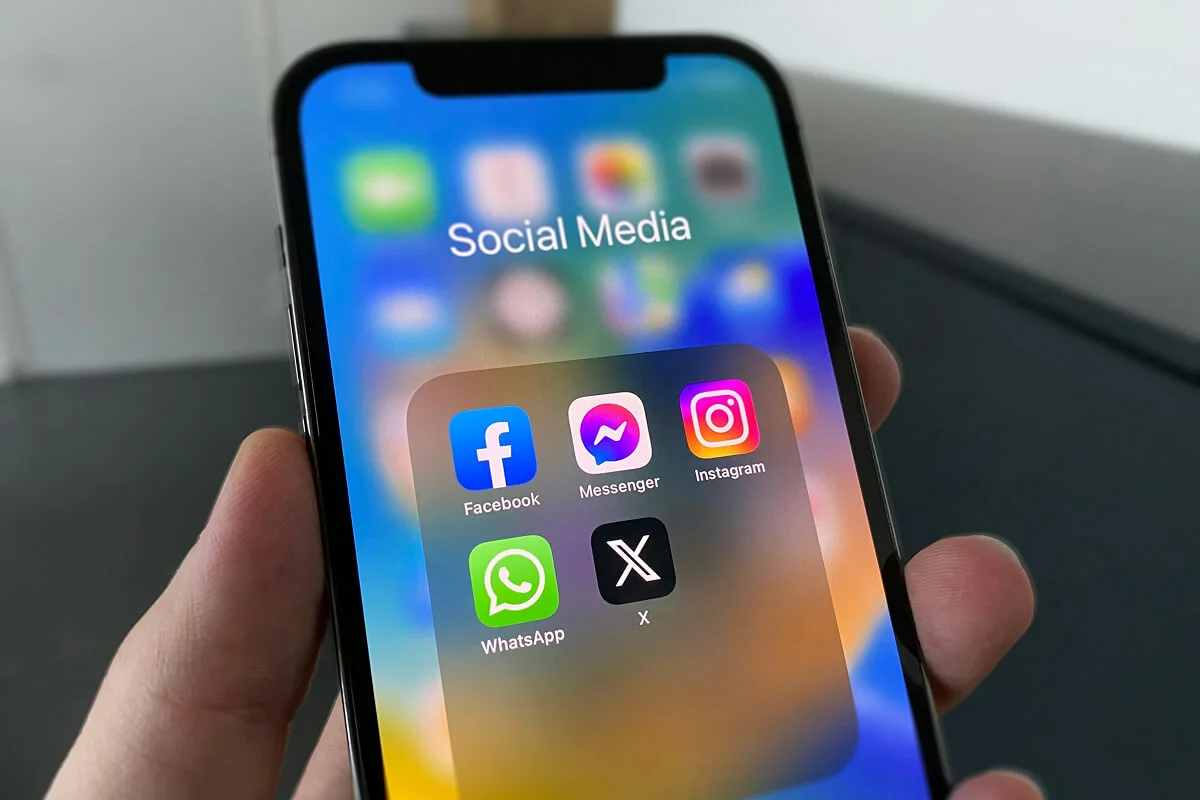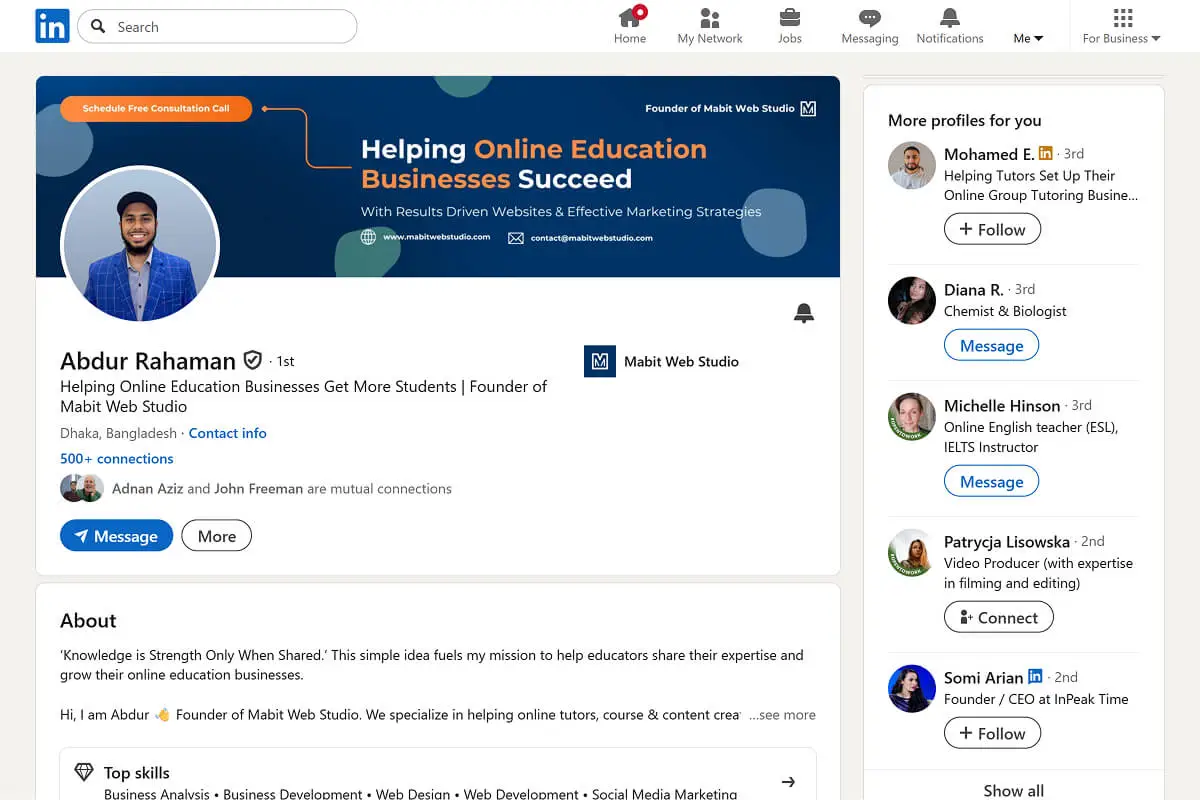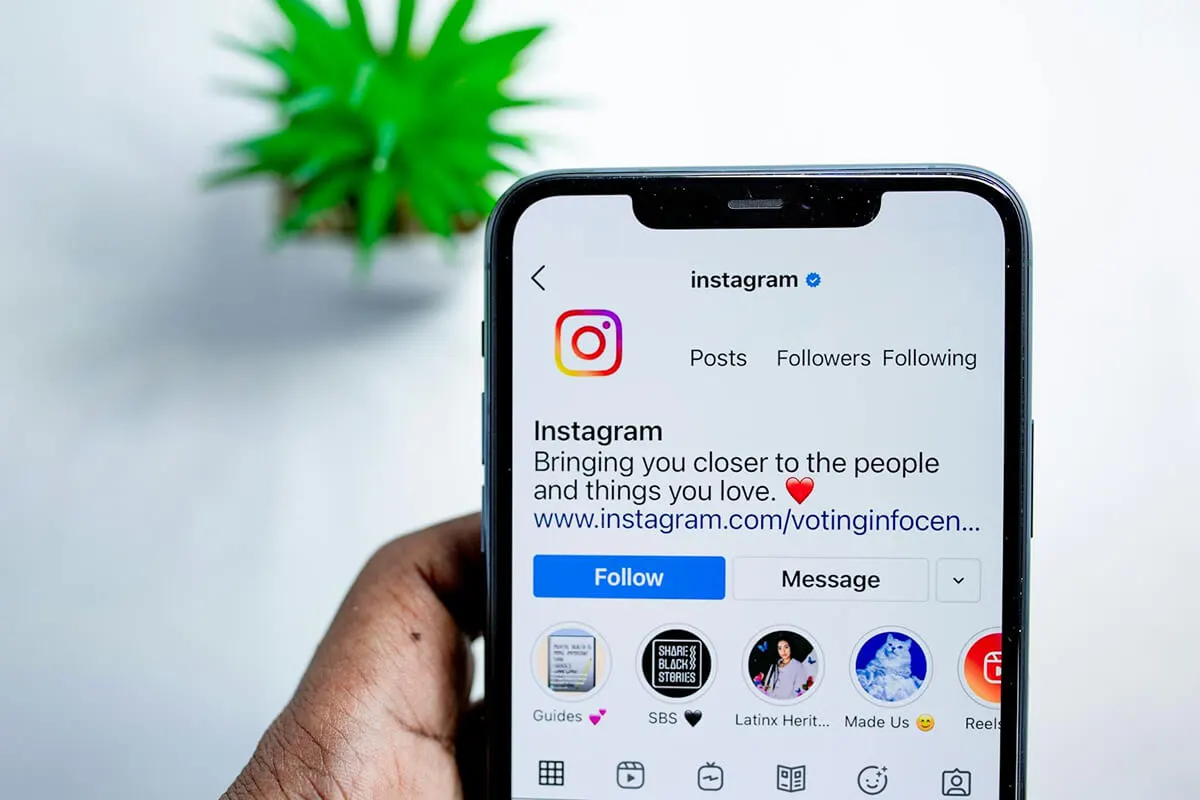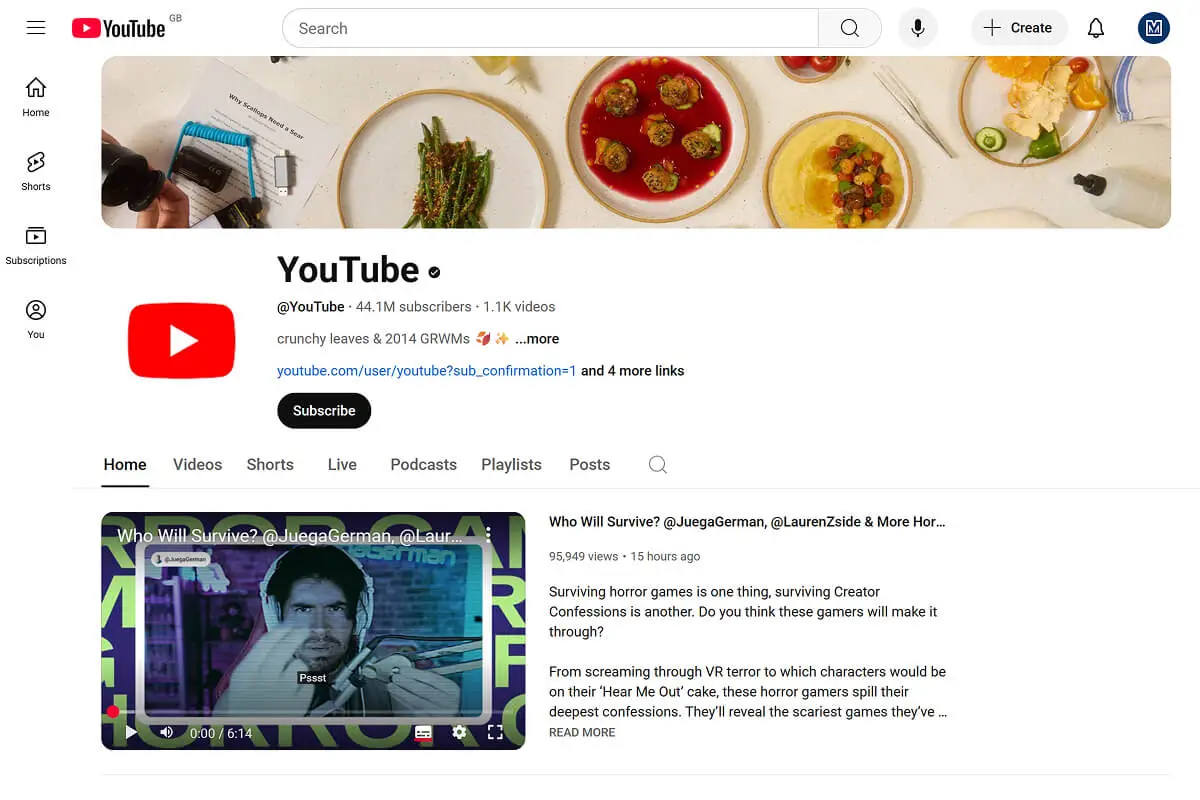Complete Social Media Guide For Your Tutoring Business
Many online tutors struggle to attract students despite being excellent at what they teach. The problem isn't your teaching skills - it's that potential students and parents can't find you online.
Here's the reality: parents search for tutors on social media before they search anywhere else. Students check your Instagram before they book a call. And if your profile looks empty or inactive, they move on to the next tutor.

Hi, I am Abdur, founder of Mabit Web Studio. For the past three years, I’ve been helping online education businesses grow with conversion-focused websites and effective marketing strategies.
In this guide, I will show you exactly how to market your tutoring business on social media with actionable strategies you can implement right away. By the end, you'll have a clear roadmap to build your online presence and attract more students consistently.
Table of Contents
Why Your Tutoring Business Needs a Social Media Marketing Strategy
Social media is where your potential students are spending their time, and it's where parents are making decisions about who to trust with their child's education.

When a parent is looking for a math tutor, they don't just search Google. They ask in Facebook parent groups. They check LinkedIn for professional tutors. They browse Instagram to see teaching styles. Your online presence is your first impression, and if you're not there, you're invisible.
Active social media profiles build credibility and social proof. When parents see consistent posts, student success stories, and genuine engagement, they trust you more.
A tutor with 100 engaged followers who posts valuable content regularly will get more inquiries than someone with 1,000 followers and no recent activity.
The difference between posting randomly and following a strategy is massive. Random posting means you share whenever you remember, with no clear goal. Strategic posting means you know who you're talking to, what they need to hear, and how to guide them toward booking a session with you.
Without a strategy, you're wasting time creating content that doesn't convert. With a strategy, every post has a purpose - whether it's building trust, showcasing results, or generating leads.
How Social Media Algorithms Work for Tutors
Understanding how social media algorithms work will save you months of frustration. Here's what you need to know.

1. Social media platforms use engagement-based ranking systems.
This means that the more people view, like, comment, share, and save your content, the more the platform will show it to others. It's not about how many followers you have - it's about how engaged your audience is.
2. Content freshness and consistency matter too.
Platforms favor accounts that post regularly. If you post once a month, the algorithm assumes you're not active and stops showing your content. But if you post 3-4 times per week consistently, the algorithm rewards you with more reach.
3. User behavior signals boost your visibility.
When someone spends time watching your full video, clicks on your profile, or shares your post with a friend, these actions signal to the platform, "This content is valuable." The algorithm then shows your content to more people with similar interests.
Here's the problem: One-size-fits-all solutions don't work across all platforms.
- LinkedIn users want professional insights and industry knowledge.
- IG users want visual, story-driven content.
- YouTube users want in-depth educational videos.
Each platform has different user demographics, content format preferences, and engagement patterns. That's why successful tutoring businesses use a multi-platform approach.
Being on multiple platforms means you're not relying on one algorithm. If Instagram algorithm changes overnight, you still have your LinkedIn and YouTube audience.
However, if you're starting or have limited time, focus on 1-2 platforms first and do them really well. Resource allocation is crucial for small tutoring businesses - it's better to dominate one platform than to be mediocre on five.
Choosing the Right Social Media Platform For Your Tutoring Business
Not all social media platforms are right for your tutoring business. Choosing the wrong one wastes time and energy. Here's how to pick the platforms that actually work for your niche.

1. LinkedIn
It’s perfect for professional networking and targeting adult learners. If you're teaching business skills, professional development, or university-level subjects, LinkedIn is where your audience hangs out. It's also great for B2B connections if you're looking to partner with schools or organizations.
2. Facebook
It’s still the dominant platform for parent communities and local networking. Parent groups are active on FB, and local community pages are where families search for tutors. If you're focusing on K-12 tutoring or local students, FB should be on your list.
3. Instagram
It attracts younger demographics and thrives on visual content. If you're teaching creative subjects, working with high school students, or want to showcase your teaching personality, IG works well. Stories, Reels, and educational infographics perform best here.
4. YouTube
It’s the second-largest search engine and works for all age groups. Whether you're teaching math, music, or marketing, YouTube lets you create long-form educational content that ranks on Google and YouTube search. It's one of the best platforms for building authority and trust.
5. TikTok
It’s where Gen Z students are. If your target audience is teenagers or young adults, and you can create quick and engaging tips, TikTok can be a powerful platform. However, intent matters. You need to determine whether your audience is interested in consuming your educational content on this platform.
To recap platform demographics:
- LinkedIn: Professionals, adult learners, career coaching. Great for B2B or corporate training.
- Facebook: Parents, local communities, older demographics.
- Instagram: Teens and younger adults.
- YouTube: All ages. Searchable educational videos are excellent for authority and SEO.
- TikTok: Gen Z. Quick tips and viral potential - best for informal, short micro-lessons (depends on audience intent).
Now, you have to match platforms to your tutoring focus. To give you an example:
- Academic K-12: FB (parents), YouTube (explainers), IG (study tips).
- Languages & soft skills: YouTube + IG Reels + LinkedIn for professionals.
- Music, arts, creative: IG + YouTube (visuals and performance clips).
- Test prep & high-value coaching: YouTube for long-form tutorials, FB/IG for lead gen and paid campaigns.
The key factor here is to know where your audience is and focus on that platform. If your audience age is under 18 academic students, you are most likely not going to find them on LinkedIn. Hence, creating content there would be a waste of effort.
Start with quality over quantity. Don't try to be on every platform at once. Choose 1-2 primary platforms based on where your ideal students are and what content format you're able to create.
Social Media Marketing Strategies for Tutoring Businesses
Each platform requires a different approach, and understanding these various strategies will help you stand out from tutors who post randomly. Here are the marketing strategies for each platform, including tactics, notes, and resources.
LinkedIn Marketing for Tutoring Businesses
LinkedIn is powerful for building professional credibility as a tutor. LinkedIn is where adult learners search for professional development, and where B2B opportunities live.

Your content strategy on LinkedIn should focus on three pillars:
1. Educational posts and industry insights
Share your expertise through posts about learning strategies, study tips, or industry trends in education. Students want to see that you're knowledgeable and staying current.
2. Student success stories and testimonials
Student success stories build trust faster than anything else. When you share how you helped a student improve their grades or pass an exam, you're showing proof of results. Just make sure you have permission before sharing student stories.
3. Behind-the-scenes teaching content
Behind-the-scenes content humanizes your brand. Share your teaching process, how you prepare lessons, or what you're learning to improve as an educator. This builds connection and shows you care about your craft.
LinkedIn Tactics To Follow:
- Post Consistently. Consistency means, if you are posting 3 times a week, be sure to stick to that schedule. Posting regularly does increase your reach. However, always remember: quality over quantity.
- You must comment 10-20+ times per day. Commenting and engaging with your audience is key to LinkedIn. Just posting content doesn’t work. You need to engage with others to increase your reach.
- Don’t use hashtags in posts. They are outdated.
- Always use a Hook at the beginning of the posts, except for personal journey posts.
- Posts with no image but a great hook and content work superb on LinkedIn.
- Connect with 20+ people in your niche daily and engage/comment on their content.
- For image posts, make sure the image has a 4:5 aspect ratio.
- Repurpose your website blogs into smaller blogs on LinkedIn.
- Share your short videos/reels here as well.
Notes on sending connection requests:
If you are starting out, don’t send too many connection requests. There is a limit on the number of connections you can send weekly. If you cross that limit, LinkedIn will flag you. The best option is to send 15-20 for 5 days a week. Also, make sure your connection invitations (requests that are still waiting) don’t go over 100+.
Resources to learn more about LinkedIn marketing:
- How to Make a Great Linkedin Profile - TIPS + EXAMPLES
- The Best LinkedIn Content Strategy in 2024
- Building A Powerful LinkedIn Presence: Tips from a LinkedIn Expert (Must watch if you are serious about LinkedIn)
Facebook & Instagram Marketing Strategy
Facebook and Instagram are Meta platforms; you can create content on both of them at the same time using Meta. So, if you are creating content on Insta, it’s super easy for you to share it on FB also.

Here are the strategies for Facebook & Instagram:
- Create content & provide value
- Diversify your content: Make sure to upload short videos and stories alongside posts. Create a mix of content formats to keep your audience engaged:
- Educational Posts: Share quick tips & study hacks about your subject, and answers to common student questions. Use infographics, carousels, and simple graphics. Don’t add promotional/salesy CTA to every post.
- Student Success Stories: With permission, share testimonials, especially photo and video ones. This is a powerful social proof.
- Behind-the-scenes Content: Share a day in the life, your workspace, your lesson planning process, screenshots of student sessions, etc.
- Interactive Content: Use Instagram's and Facebook's built-in features like polls, quizzes, Q&A stickers, and "ask me anything" sessions in your Stories.
- Create High-Value Content Regularly: Post on the platforms consistently. Consistently doesn’t mean every day. If you post three times a week, you must stick to that schedule every week.
- Diversify your content: Make sure to upload short videos and stories alongside posts. Create a mix of content formats to keep your audience engaged:
- Engagement & Community Building
- Targeted Hashtags: Use only 3 hashtags. 2 niche/subject-focused and one broad. For example: #onlineesltutor #englishtutor #onlinetutor. The first 2 are subject-focused, the last one is broad.
- IG Engagement: Regularly comment on 15-50+ posts from your audience’s and other tutors. Make sure the comments are genuine and provide value.
- Build a community on IG: Regularly follow your audience accounts and tutors and connect with them via comments & DMs. (At least 20-50 accounts for IG)
- Create/Join FB Groups: Join existing tutoring groups, educational groups, and provide genuine value. Don’t post sales & promo content there immediately after joining. You can also create your own tutoring group once you have an audience.
- Optimization & Analytics
- Post at Optimal Times: Review your analytics and schedule posts for times when your audience is most active. Posting time does matter for certain posts.
- Analyze Your Top-Performing Content: Regularly review your analytics to see which posts get the most likes, saves, shares, and comments. This tells you what your audience loves, so you can create more content like it.
- Schedule Posts in Advance: Use Meta Business Suite to schedule content ahead of time. This allows you to maintain consistency and reduces the pressure of daily posting.
- Conversion
- Clear Calls to Action (CTAs): Use a strong, clear call-to-action to guide your audience to the next step. These CTAs can be: check the link in bio, DM us for more info, comment below, save this reel, etc.
- Optimize Your Bio/Profile: Your bio is prime real estate. Make sure it clearly states who you are, what you offer, and has a single link to your website, a lead magnet, or a booking page.
Notes For Facebook:
FB Groups used to be a goldmine for tutors. However, according to my recent research, most existing FB groups are nowadays inactive. Recommend testing it out before committing full efforts to this.
In recent years, Meta has reduced its organic reach to encourage users to rely more on its ads. (Personal Opinion) This is one of the reasons Business Pages don’t get enough reach without advertising.
What successful tutors do here is that they have 2 accounts:
- Professional Creator Account (Personal Brand)
- FB Business Page for their tutoring business
They create educational content under their personal brand, while running advertisements and promotions from their business page.
Notes For Instagram:
Short reels perform very well on Instagram compared to image posts. You should put a heavy focus on creating short-form videos for your Instagram. (Be sure to post them as YouTube shorts, too.)
Notes for Paid Advertisements on Meta:
Paid advertising on FB and IG can work for tutoring businesses, but only when you have a clear funnel, well-built landing pages, and an overall well-structured ad strategy.
Don't run ads to get followers. Run ads to get people to sign up for a free consultation, download a study guide, or register for a webinar. Target parents in your local area or specific demographics that match your ideal student profile.
Resources to learn more about FB & IG Marketing:
- Instagram Marketing For Small Business (2025 UPDATE)
- Instagram Marketing Guide: 11 Tips That Actually Work - Neil Patel
- Instagram Marketing: The Ultimate Guide
- Facebook Marketing for Beginners
- How to Run Meta Ads For Beginners
- Facebook Ads Tutorial - 2025 FREE COURSE for Beginners
YouTube Marketing for Educational Content
YouTube is the second-largest search engine after Google, and educational content performs incredibly well there. When students search "how to solve quadratic equations" or "Spanish grammar tips," they're looking for video explanations.
The long-form educational content opportunity on YouTube is unmatched. You can go deep into topics, show your full teaching style, and provide real value that builds trust. Plus, YouTube videos rank on both YouTube and Google search, giving you double the SEO benefits for your tutoring business.

YouTube video content creation strategy has 4 key phases:
Phase 1: Find Video Topic & Keyword Research
- To find video ideas and what your audience is looking for:
- Start by writing down the pain points your audience is facing.
- Look at forums & communities to see what your audience is asking.
- Look at what videos your competitors are creating.
- Do a quick Google and YT search on your topic and take notes.
- How to do keyword research for your videos:
- Take notes of search terms on YouTube autocomplete.
- Take notes of keywords your competitors are using for that topic.
- Use tools like AnswerThePublic, Ubersuggest & AlsoAsked to find keywords and long tail questions.
- Use tools like TubeBuddy & vidIQ to find video keywords and their search volume on YT.
Phase 2: Video Planning & Recording Strategy
- How to structure your videos:
- Start with a Hook: Ask a bold question, show a result, or promise a transformation.
- Delivery Value: Use frameworks like: Problem -> Solution -> Proof or “3-Step Breakdown”.
- Call To Actions (mid + end): Invite comments, likes, or guide viewers to the next video in your funnel.
- Recording Tips:
- Batch record: Film 3-5 videos in one session to stay consistent and reduce setup fatigue.
- Script smart: Use bullet-point outlines, not word-for-word scripts, to stay natural.
- Visual layering: Add screen recordings, B-roll, or animated overlays to boost engagement.
Phase 3: Optimization for Discovery & Conversion
- Title Strategy
- Use Keyword + Emotion + Curiosity. Example: “How This Student Went from X to Y within Z time”
- Avoid clickbait: Promise value and deliver it.
- Description Strategy
- First 2 lines = SEO gold: Include primary keyword and a compelling summary.
- Timestamps: Help with navigation and SEO.
- Links: Funnel viewers to your site, lead magnet, or next video.
- Hashtags & Tags
- Use only 3 relevant hashtags. 1 Broad and 2 Niche. For example: #mathtutor #calculus #geometry
- Add tags that match your video content, keyword clusters and competitor tags.
- Thumbnail
- Use canva.com to design thumbnails.
- The thumbnail should immediately convey to the audience what the video is about and the value it provides.
Phase 4: Post-Publish Strategy
- Promotion
- Share the video link on your social media.
- Embed the video inside your relevant blogs or articles & email newsletters.
- Repurpose long videos into YT Shorts & Instagram Reels.
- Analytics & Iteration
- Track CTR, retention, and comments.
- Double down on formats/topics that outperform.
- Use audience feedback to refine future scripts and thumbnails.
This is the basic structure of creating videos on YouTube. There is more to discuss about YouTube Marketing, which requires its own standalone article.
Resources to learn more about YouTube Marketing:
- How To Create A YouTube Channel! (2025 Beginner’s Guide)
- If I Started a YouTube Channel, I’d Do This!
- YouTube Shorts VS Longs (My new strategy for growth)
- How YouTube Wants You to Make Shorts (2025 Guide)
Content Creation Strategy for Tutoring Businesses
Creating content without a strategy leads to burnout. You need a system that makes content creation sustainable while actually generating results.

Your content pillars for educational businesses should follow this breakdown:
- 40% educational content, like guides, tips, mini-lessons, and insights that help your audience for free.
- 30% social proof, including testimonials, success stories, and student results that show you get results.
- 20% behind-the-scenes content showing your teaching process and personality so people connect with you.
- 10% promotional content about your services, offers, and calls-to-action.
This ratio keeps your audience engaged without being overly promotional. If every post is "book a session with me," people tune out. However, if you consistently provide value and occasionally promote your services, it feels natural.
Content formats that engage:
- Video content, such as educational tips and explainer videos, performs best across all platforms.
- Visual content, such as infographics, study guides, and tips, gets saved and shared.
- User-generated content from student success stories provides authentic social proof.
- Interactive content, such as polls, Q&As, and live sessions, boosts engagement signals.
Content planning and consistency require an editorial calendar:
- Plan your content a month ahead so you're not scrambling daily.
- Batch content creation strategies save a massive amount of time - dedicate one day to recording 4-5 videos or writing 10 posts, then schedule them out.
- Repurposing content across platforms means that one article can become a LinkedIn post, an Instagram carousel, a YouTube video, and an email newsletter.
Measuring content performance is crucial. Track key metrics like engagement rate (not just likes), click-through rates to your booking page, and actual conversion to paying students. Adjust your strategy based on data - if educational Reels perform better than static posts, create more Reels.
Lastly, be sure to keep SEO in mind. SEO and keywords apply to every social media platform. I have covered more about SEO in this article: How SEO Helps Your Tutoring Business Grow.
How to Implement a Social Media Marketing Strategy
Strategy means nothing without implementation. Here's your step-by-step roadmap to actually execute what we've covered.

Phase 1: Foundation (Weeks 1-2)
1. Start with platform selection based on where your target audience spends time. Don't overthink this, pick 1-2 platforms and commit.
2. Optimize your profiles completely. Your bio should clearly state who you help and what results you deliver. Use a professional photo. Include a link to your booking page or website.
3. Conduct competitor analysis by finding 5-10 other tutors in your niche who are active on social media.
Study what content gets the most engagement. Note what's missing from their content that you could provide. Position yourself uniquely - don't just copy what others are doing.
Phase 2: Content Creation (Weeks 3-6)
1. Develop your content pillars based on the 40-30-20-10 ratio mentioned earlier.
2. Create an editorial calendar for the next month. Plan specific posts for specific days so you're not creating content on the spot.
3. Create your initial content batch before you start posting. Record 5-10 videos, design 10-15 graphics, and write captions in advance. This gives you breathing room and ensures you stay consistent even during busy weeks.
Phase 3: Engagement and Growth (Ongoing)
1. Community building strategies include responding to every comment on your posts, engaging with your followers' content, and actively participating in relevant groups or conversations. Social media isn't a broadcasting tool, it's a two-way conversation.
2. Performance tracking and optimization means reviewing your analytics weekly.
- Which posts drove the most profile visits?
- Which content got the most saves?
Double down on what works and eliminate what doesn't. Test new content formats regularly, but give each test at least 3-4 weeks of data before making decisions.
How MWS Can Help Your Tutoring Business With Social Media Marketing
At Mabit Web Studio, we understand that online tutors and education businesses have hectic schedules. You're focused on teaching students, not figuring out Instagram algorithms or creating content calendars.
That's where we come in. We help online tutoring businesses with social media marketing services, including:
- Strategic social media management to boost engagement.
- Content creation that resonates with students & tutors.
- Platform-specific strategies (Facebook, Instagram, LinkedIn, & YouTube).
- Community building and brand awareness for long-term growth.
- Performance tracking and improvements for better results.
If you're interested in growing your tutoring business through social media but don't have the time to do it yourself, let's have a conversation. Schedule a free consultation call with me, or request a free business analysis from our website.
Common Mistakes and How to Avoid Them
Even with the best strategy, these mistakes can sabotage your social media marketing efforts:
1. Over-promoting services without providing value is the fastest way to lose followers.
Nobody wants to follow an account that only says "book now" in every post. Follow the 40-30-20-10 content ratio to balance value with promotion.
2. Inconsistent posting schedules confuse the algorithm and your audience.
If you post daily for a week, then disappear for a month, people forget about you. Aim for 3-4 posts per week minimum on your primary platform and stick to it.
3. Ignoring platform-specific best practices means wasting effort.
Don't post the same exact content format across all platforms. Adapt your content to fit each platform's strengths - carousel posts for Instagram, long-form videos for YouTube, professional articles for LinkedIn.
4. Not engaging with your audience is a huge missed opportunity.
Social media algorithms reward engagement, and potential students want to see that you're responsive. Spend 15-20 minutes daily engaging with comments, messages, and other people's content in your niche.
5. Focusing on vanity metrics instead of conversions is a common trap.
Having 10,000 followers means nothing if none of them book sessions. Track metrics that matter: profile visits, link clicks, consultation bookings, and actual students gained from social media.
FAQs About Social Media Marketing
1. How often should I post on social media as a tutor?
Aim for 3-4 times per week on your primary platform. Consistency matters more than frequency.
It's better to post 3 times weekly consistently than to post daily for a week and then disappear. Different platforms have different optimal frequencies - LinkedIn works well with 3-4 posts per week, Instagram thrives on daily content, and YouTube can work with 1-2 quality videos per week.
2. Which social media platform is best for tutoring businesses?
It depends on your niche and target audience.
- LinkedIn works best for professional development and adult learners.
- Facebook is ideal for reaching parents of K-12 students.
- Instagram attracts younger demographics and works well for visual subjects.
- YouTube is universal and works for all subjects and age groups.
Start with the platform where your ideal students spend the most time.
3. How long does it take to see results from social media marketing?
Realistically, expect 3-6 months of consistent effort before seeing significant results. The first month is building your foundation and learning what works. Months 2-3 are about refining your strategy based on data.
By months 4-6, you should see increased engagement and student inquiries. Social media is a long-term strategy, not a quick fix.
4. Do I need to be on every social media platform?
Absolutely not. Being on every platform spreads you too thin and leads to mediocre results everywhere. Focus on 1-2 platforms where your target audience is active and where you can create content consistently. Master those platforms before expanding to others.
5. How do I create engaging content if I'm not comfortable on camera?
In today’s attention economy, video is non-negotiable. Audiences connect with faces, voices, and energy. It builds trust, credibility, and memorability.
If you're not comfortable on camera yet, treat it as a skill to develop, not a barrier. Start small, practice often, and lean into formats that feel natural. If you have multiple tutors or partners in your business, delegate video creation to team members who shine on camera.
6. Should I use paid advertising for my tutoring business?
Start with organic content first. Build an engaged audience and understand what resonates before spending money on ads.
Once you have proven content that converts and a clear funnel, paid advertising can accelerate your growth.
Facebook and Instagram ads work well for tutoring services, while YouTube and Google ads can target specific search keywords.
Conclusion
Social media marketing for your tutoring business is not about being everywhere, it’s about being where your students are. The tutors who succeed online are those who show up consistently, provide genuine value, and build authentic connections with their audience.
After going through the social media marketing strategies and resources, here's what to do next:
- Choose 1-2 platforms based on where your ideal students are.
- Set up your profiles professionally with clear messaging about who you help.
- Create a content calendar for the next month using the 40-30-20-10 content ratio.
- Start posting consistently and engage with your audience daily.
- Track your metrics and adjust your strategy based on what works.
Remember, you don't have to do this alone. If managing social media feels overwhelming on top of teaching students, Mabit Web Studio can help. We specialize in helping online tutoring businesses grow through effective social media marketing strategies.
Ready to attract more students and grow your tutoring business? Schedule a free consultation call with me or request a free business analysis from our website. Let's create a social media strategy that actually works for your tutoring business.


